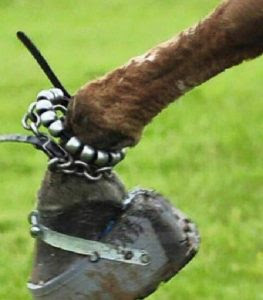Last month, the 82nd annual Tennessee Walking Horse National Celebration wrapped up in Shelbyville, IN.
It’s an event that’s been brewing with controversy for more than half a century because of soring, where trainers inflict pain to horses’ front feet and legs to produce an artificial exaggeration of the natural gait, the “Big Lick.”
Before trainers began resorting to soring as a core strategy in the 1950s and 1960s, the Tennessee Walking Horse had been known as America’s Horse, and was one of the fastest growing breeds the world had ever seen, proudly ridden, and treasured by Roy Rogers, Dale Evans, John Wayne, and even President Lyndon B. Johnson.
But the negative stigma of soring eventually ran off most Americans who didn’t want to be associated with the abuse. I recall meeting Zsa Zsa Gabor at the Celebration as a child and sitting in her lap watching the show, and remember Randy Owen, the lead singer of the band Alabama visiting on many occasions. Even Heavyweight Champion George Foreman once rode aboard a walking horse in Shelbyville.

Today, it’s such a tainted breed that it’s dying on the vine.
Fifteen years ago, I recognized that the breed was headed in a downward spiral due to the soring stigma and decided to try and make change. Residing in Shelbyville, I launched a successful campaign for election to the Tennessee Walking Horse Breeders’ & Exhibitors’ Association’s (TWHBEA) board of directors and found myself on most occasions the youngest person in the room—usually by at least a decade or two.
It was my hope that from within, I could help transition the breed away from soring, end the use of large stacked shoes and ankle chains that are rampantly utilized on the horses feet in competition to exacerbate the pain induced to the legs; and eventually return the breed to the sound and naturally gaited flat-shod horse that was the foundation of its earlier success with champions such as Midnight Sun and Merry Go Boy.
In my first meeting as a director I made a motion to add a trail pleasure flat-shod division to TWHBEA’s National Futurity. The motion met staunch opposition from Tennesseans like W. David Landrum, then one of the top “Big Lick” trainers in the breed. Fortunately, after a heated debate, we prevailed, and the division was added in 2006.
Following that first event’s successful participation, I wrote a letter to the Celebration pleading the case to add a two and three-year-old trail pleasure division to the world championship show, and the next year they did. The class was so full of horses it was split into two divisions.
Now more than a decade later, the trail pleasure events generally garner more horses than the “Big Lick” classes with stacked shoes and ankle chains that have dwindled to only three or four horses competing in some events.
But despite the very clear popularity of the new divisions, and dwindling archaic “Big Lick” events, the old guard is still determined to hang on the painful past, and they’ve maintained control of the breed with the mentality that it’s their “God given right to sore their horses.” Yes, I’ve actually heard recent TWHBEA directors make that statement.

A horse’s foot wearing chains and stacked shoes is still legal and is integral to the illegal practice of soring, says Marty Irby, executive director of Animal Wellness Action. Photo credit: Bradley Dick
In 2013, after years of trying to make change from within, I decided to launch a public campaign to end soring by supporting the Prevent All Soring Tactics (PAST) Act that would eliminate the use of large stacked shoes and ankle chains on the horses’ feet; eliminate the industry’s corrupt self-policing scheme; and increase penalties for violators caught soring.
The backlash from within the breed was fierce and eventually left me no choice but to leave the state for my own personal safety.
Now seven years later, I’m still working on it, but as a leader of an animal protection group with the capacity to make lasting change. We’ve built enormous political support for our position in the Congress, but the horses appear to be as sore as ever.
The defenders of the status quo are shrinking in number, and these insiders are concentrated in a five or six county area centered around Bedford County—still hanging on to their chains.
It amazes me that even amidst the times we live where Confederate statues are being toppled and dismantled, and state flags and the names of football teams are being changed, that these relics of the past remain front and center on the horses’ feet.
It took 81 years for the Celebration to ban the display of Confederate flags on the showgrounds, something implemented this year. How long will it take to ban the stacks and chains?




 October 26, 2020
October 26, 2020 






















